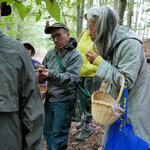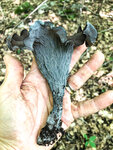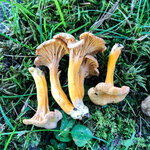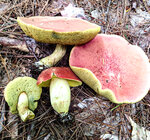



WITH ALL THIS RAIN we've been having, we finally have a summer filled with fungal fruiting and are relieved from our almost normal drought conditions.
After a recent talk on mushroom identification sponsored by the Manchester Public Library, I led a walk in the woods. Here is a report on some of the fungi that are fruiting in the forests around us:
MILKY CAPS: Lactarius species with white milk exuding from their gills when cut. Very tasty edibles if roasted in the oven. (l., Lactarius hygrophoroides and volemus specifically).
WAXY CAPS: These small brightly colored mushrooms resemble Chanterelles but have rounded caps with a waxy feel to them. Their gills are also brightly colored. Ours had a bright red cap and bright yellow gills. They are edible but too insubstantial to bother with, in my opinion. (l., Hygrocybe splendidissima).
THE SPOTTED BOLETE: These are very common in our area and are edible if you can find them bug free. (l., Xanthaconium affine).
THE BITTER BOLETE: These too are common but are easy to identify but so bitter you wouldn't want to eat them anyway. (l., Tylopilus felleus).
THE PAINTED SUILLUS: Though this is really common in the fall, these summer rains seem to have brought them out too. (l., Suillus spraguei).
THE ROOTING COLLYBIA: These elegant, thin mushrooms have very long 'roots' going as much as a foot underground. They are also reputed to be edible, but I only find one at a time, at most, so I don't bother. (l., Xerula furfuracea).
BLACK TRUMPETS: These much sought-after little critters so resemble dry or dead leaves that they are very easy to miss. They are extremely popular for cooking with and easy to dry to save for later. (l., Craterellus fallax).
CHANTERELLES! We were delighted to find a patch of brightly colored orange Chanties. Typically, one finds the yellow variety, but Sunday was a lucky day. They're all equally edible and are just beginning to start their fruiting season. Ours were beautiful but quite small and young. Keep an eye out for these. (l., Cantharellus cibarius group).
And of course, there were lots of colorful, but hard to identify, Brittle Caps, or Russula species, as always.
If you're familiar with any of these species, and know their look-alikes, I suggest you get out in the woods and see what you can find. I will be offering free guided walks in the coming weeks via Essex County Trails, Essex Greenbelt and the Boston Mycological Club as well as to those who have come to my classes and signed up.
Happy hunting!